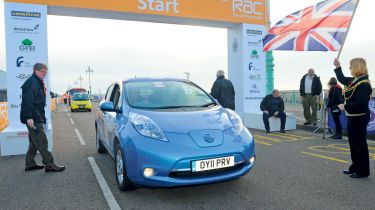Nissan Leaf: Second report
We put our electric car to test on the Brighton to London run
Sixty miles. Doesn’t sound very far, does it? You could do that on a single gallon of diesel in a VW Golf. But it feels a long way when you’re at the wheel of an electric car. I know, because I’ve done it. Twice.
The Brighton to London RAC Future Car Challenge took place late last year, and Auto Express joined a host of other EVs, super-efficient hybrids and range-
extenders in our all-electric Nissan Leaf.
The route reversed the original 1896 London to Brighton run, and the challenge was to use the least amount of energy from Madeira Drive, Brighton, to Pall Mall, London.
However, I had to first get to Brighton from our offices in London’s West End. No mean feat when you consider the furthest our Leaf had travelled between top-ups was around 40 miles and a few office sceptics reckoned 65 miles was about its limit.
With a 6am start required for the ‘race’, I headed to Brighton on the previous night. The Leaf was fully charged when I left our car park, showing a range of 112 miles. Sounds easy, right? Knowing that this figure can be optimistic at best, I picked my way through Piccadilly Circus traffic with trepidation, and used every opportunity to coast down hills to regenerate the batteries while driving through south London.
Used - available now
It was surprisingly easy to conserve energy in town, although I quickly came unstuck on the M23. Even at 55mph, the range dropped by around three miles for every mile travelled. Hills were even worse. At this rate, I would be calling a tow truck.
Then a Tesco articulated lorry joined the motorway. I’m not ashamed to admit that I slipstreamed it for 25 miles. This desperate hypermiling technique – combined with not using the heater or de-mister once – meant I arrived in Brighton with 33 miles to spare.
My sense of achievement was tainted by the thought that this wasn’t the way future motoring should feel. Plus, the car needed a solid eight hours of charging in order to complete the return journey. It was now 11pm, so it was going to be close. However, the RAC found somewhere for me to plug in and I went to bed to rest my frayed nerves.
The actual ‘race’ back to London was easy. The Leaf and I had done the hard work the night before – and we’d become even more accomplished at driving efficiently. Plus, the route skipped the M23 and A-roads, which did wonders for the range.
While some competitors caused big tailbacks by driving well below the limit, I refused to hold up traffic and drove in a pretty normal fashion, crossing the finish line in Pall Mall with 44 miles of range left. That gives a total range of just over 100 miles – which is about what Nissan claims.
So, was it a success? On the one hand, the event proved that the Leaf can match the official claims; but on the other, the car felt out of its depth outside the city. Once a country-wide network of fast chargers is in place, range anxiety will be a thing of the past. But right now, that seems some way off.
Extra Info
“The car’s charging cable is cumbersome. And although we have a Source London card, there are so many different charging bays in the capital, we need to get an another type, so we can use more of them.”
Ross Pinnock, Road test editor
“Once Nissan increases the Leaf’s range to a real 200 miles, and drops the price to between £18,000 and £24,000, it’ll sell big.”
Mad_Lad, via www.autoexpress.co.uk











